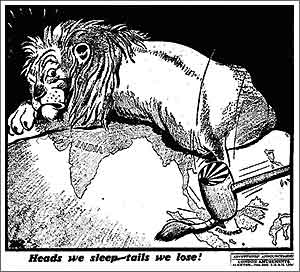| Contents > “Roar Britannia?” by Bridget Deane |
| Page 1 | 2 | 3 | 4 | 5 | 6 |
“Roar Britannia?”

Figure 1. Philip Zec
This paper will focus on how it is possible to use editorial cartoons, from Australian and British newspapers, supported by newspaper reports, for discovering how events in the Far East (1941 – 1942) were perceived, not only by the cartoonists but also by the general public. In effect, the cartoons provide a commentary on the political (and war) situation at the time, reflect popular opinion, and sometimes manifest criticisms of Britain’s responsibilities towards its territories in South-East Asia as well as Australia. The work of the following cartoonists will be discussed: from Australia, Bill Mahony (Sydney Daily Telegraph), Mick Armstrong (The Argus) and Ian Gall (Courier Mail) and from Britain, Philip Zec (Daily Mirror), Sidney Strube (Daily Express) and Wyndham Robinson (The Star). This is just a small selection of the cartoons available; there were many other excellent cartoonists recording the events of the war, for example, David Low, Leslie Illingworth, and James McClelland, but unfortunately there is not space here to include their work.
Darracott (1989) explains that ‘All cartoons have value as historical evidence since they are documents in their own right; but like other written documents they require careful interpretation’ (p.143). Therefore it is necessary to keep in mind some questions when using editorial cartoons as a source: how accurately do the cartoons reflect the situation in the Far East, or what was known about events there? Are they a form of propaganda – official or unofficial? Can the cartoons be seen as entertainment and a way of encouraging or boosting the morale of readers or the population at large? What impact did the cartoons have when they were published? Perhaps that is the most difficult question to answer, as there is little evidence available, although a few caused controversy at the time they appeared, for example, Philip Zec’s ‘The price of petrol has been increased by one penny: Official’, which unintentionally offended Churchill and his government (Donald Zec, 2005).
Moreover, when decoding cartoons for the meaning embedded within them, it is important to recognise that we look at these drawings with the benefit of hindsight. We may have more, or less knowledge of the events concerned than the audience for whom they were intended. Also, we look at them from a different perspective, being so far removed from the time they were produced, in this case over sixty years; therefore our interpretation of the editorial cartoons may be different from that intended by the cartoonist. Additionally, as Bryant (2005) comments, it is difficult for us now to understand the
-
immense impact of cartoon art in pre-TV days … to a news-hungry public anxious about world affairs, the radio was a lifeline, but it was the political cartoon with its immediacy and universal accessibility - even to the barely literate – that could speak the message mere words could never convey (p. 7).
The cartoons chosen concern events leading up to the fall of Singapore on 15 February 1942 and beyond. My interest in editorial cartoons of this period came through research I am undertaking into the evacuation of women and children from Malaya to Australia during the Second World War. It was literally by accident that my attention was caught by editorial cartoons in newspapers I was looking at. What attracted me first was the humour and quality of the artwork displayed in the drawings. Also I noticed how animals were used to represent the countries involved and the fact that they were instantly recognisable (although labels often provide additional information). Great Britain is a lion or bulldog, the latter particularly associated with Churchill who became Prime Minister in May 1940, but also with the phrase “the bulldog breed”, used to describe the British people; the bulldog, of course, bred as a fighting dog. Australia is seen as a kangaroo, lion or bulldog, the last two emphasising the close relationship between the dominion and mother country. Japan comes in a variety of guises – tiger, rising sun, ape, panther. Finally, I became aware of what an important source editorial cartoons can be for an historian. They add a dimension to the historical narrative that cannot be just expressed by words. As Roy Douglas (1990) comments, ‘… the cartoon often preserves a vitality which has been lost from factual accounts of events’ (p. xi).
| Page 1 | 2 | 3 | 4 | 5 | 6 |
| Contents > “Roar Britannia?” by Bridget Deane |
